#Christina Nilsson
Photo



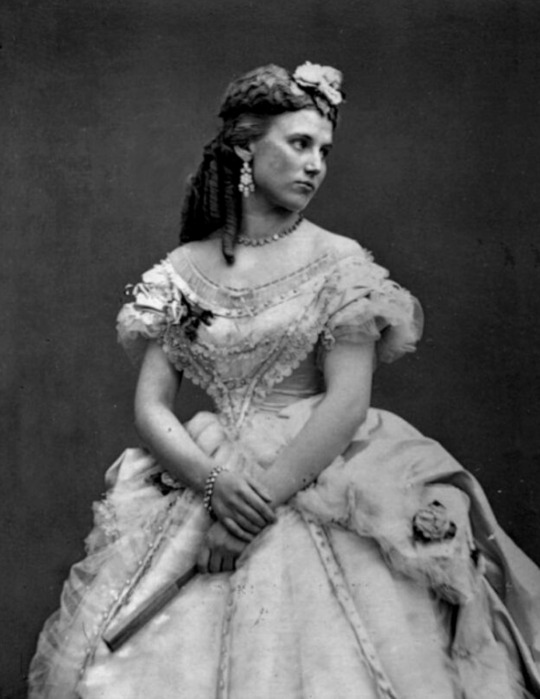
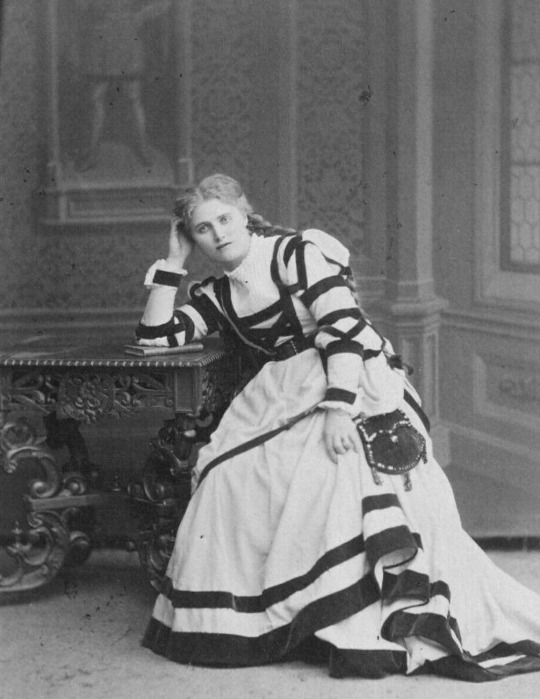
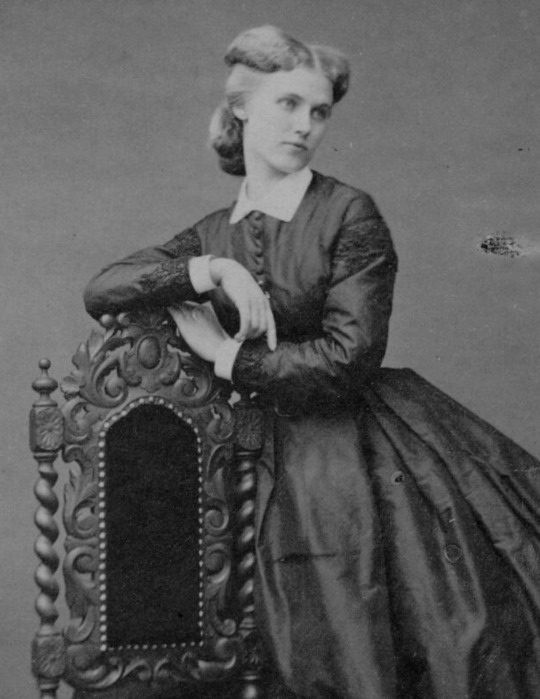


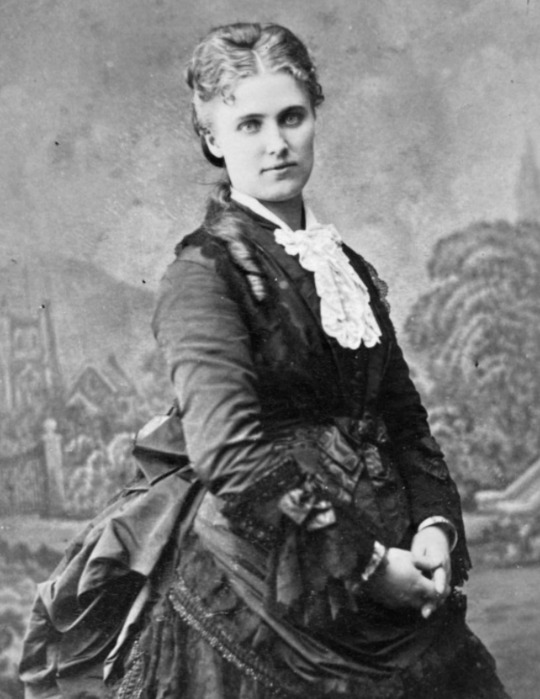
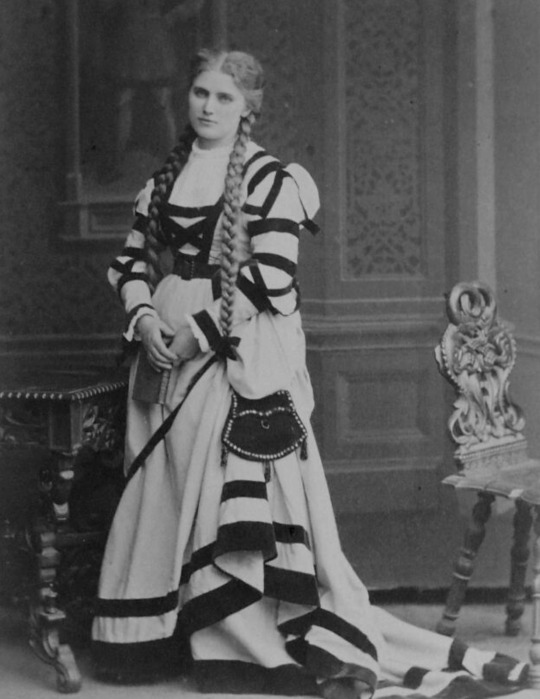
christina nilsson (1843-1921) was a swedish operatic soprano. nilsson is widely believed to have been the inspiration for christine daaé, the heroine of gaston leroux’s novel the phantom of the opera. towards the end of his life, leroux claimed the character was based on a real opera singer “whose real name I hid under that of christine caaé”, and details of nilsson’s early life heavily reflect details in the fictitious christine daaé’s history.
#plus they kinda of resemble the character#history#christina nilsson#the phantom of the opera#gaston leroux#photography#vintage photography#victorian era#vintage#19th century#christine daae#ph#beauty#women in history
506 notes
·
View notes
Text

Shared from my Instagram—I figured if anyone had any leads or helpful info, it would be the fine folks of tumblr.
The blue is just a placeholder for now…and I’m not sure about the wig color either. Or if it even is a wig. Some of Christina Nilsson’s photos have these big bumps on the top of the head (which I’m partial to for the drama) but then others look like a much more naturalistic Dutch braid of some kind.
#I know it’s just fiction and I’m only one person trying to do everything but I do try to be accurate even if it doesn’t always show lol#if I had the money I’d have a historical fashion expert on staff I’m not even kidding.#fantomestein#christine daae#Christina Nilsson#poto#phantom of the opera
69 notes
·
View notes
Text

March 5. 1868 the first performance of Arrigo Boito’s Opera “Mefistofele” was presented at the Scala di Milano. Here we see the very rare original castlist from the first performance of this Opera at The Metropolitan Opera 1883 six weeks after the opening from the MET.
#classical music#opera#music history#bel canto#composer#classical composer#aria#classical studies#maestro#chest voice#Arrigo Boito#Mefistofele#La Scala#Metropolitan Opera#Met#Christina Nilsson#Christine Nilsson#dramatic coloratura soprano#coloratura soprano#soprano#Swedish Nightingale#The Nightingale#classical history#classical musician#classical musicians#opera history#historian of music#musician#musicians#diva
11 notes
·
View notes
Note
don’t know if you watch it at all but the first episode of season 2 of The Gilded Age has a rich character hire Christina Nilsson to perform the Jewel Song from Faust
I don't watch it (I am bad at shows), but it's been recommended to me, and I just recently heard about the Christina Nilsson bit! so cool!
8 notes
·
View notes
Text
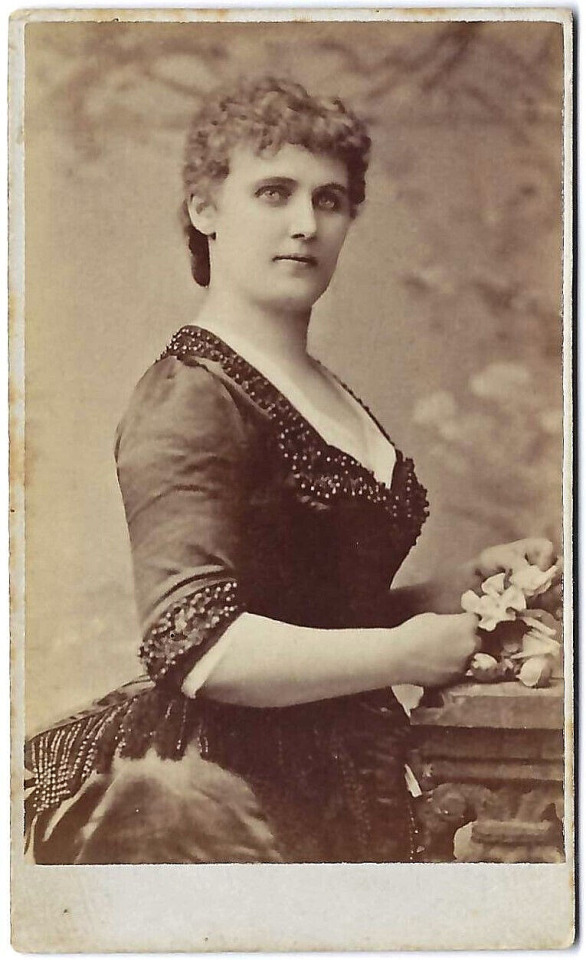
#christina nilsson#christine nilsson#christine daaé#opera#singer#bel canto#soprano#dramatic coloratura soprano#the nightingale#swedish nightingale#swedish opera singer#the phantom of the opera#le fantôme de l'opéra#gaston leroux#paris opera#her majesty’s theatre#drury lane#covent garden#royal albert hall#royal opera house#the metropolitan opera#mariinsky theatre#photography#classical singer#classical singing#classical music#music history#classical studies#diva#aria
14 notes
·
View notes
Text
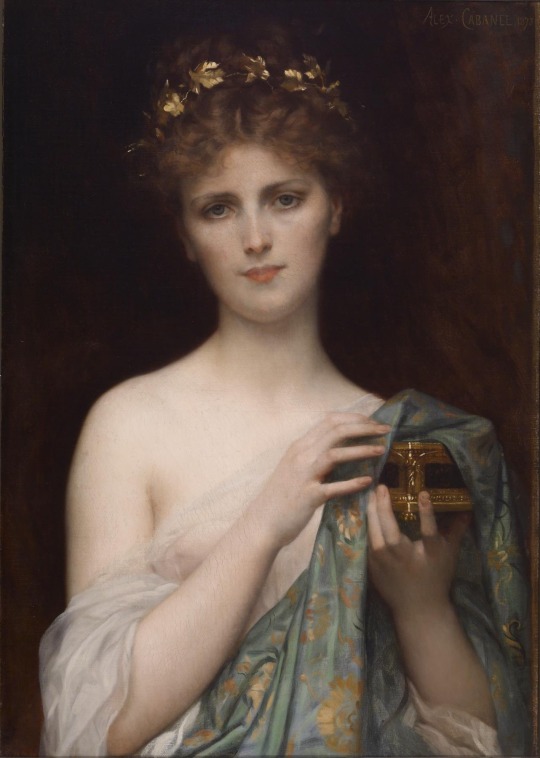
Pandora by Alexandre Cabanel
#pandora#pandore#mythological#painting#art#alexandre cabanel#realism#portrait#pandoras box#greek mythology#swedish soprano#christine nilsson#christina nilsson#forbidden box#model
32 notes
·
View notes
Text
1908 Christina Nilsson by ?. From Wikimedia 394X533.

#1908 fashion#1900s fashion#Belle Époque fashion#Edwardian fashion#Christina Nilsson#feathered hat#blouse#high neckline#bow#jacket#lapels
1 note
·
View note
Photo


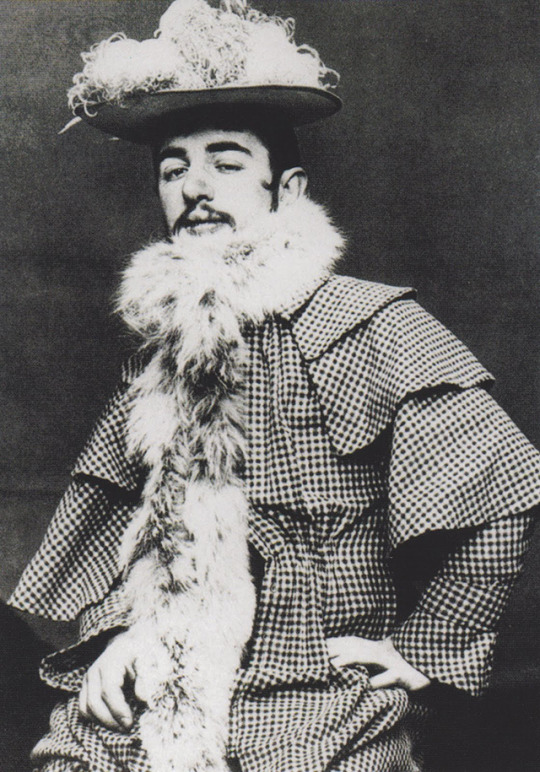


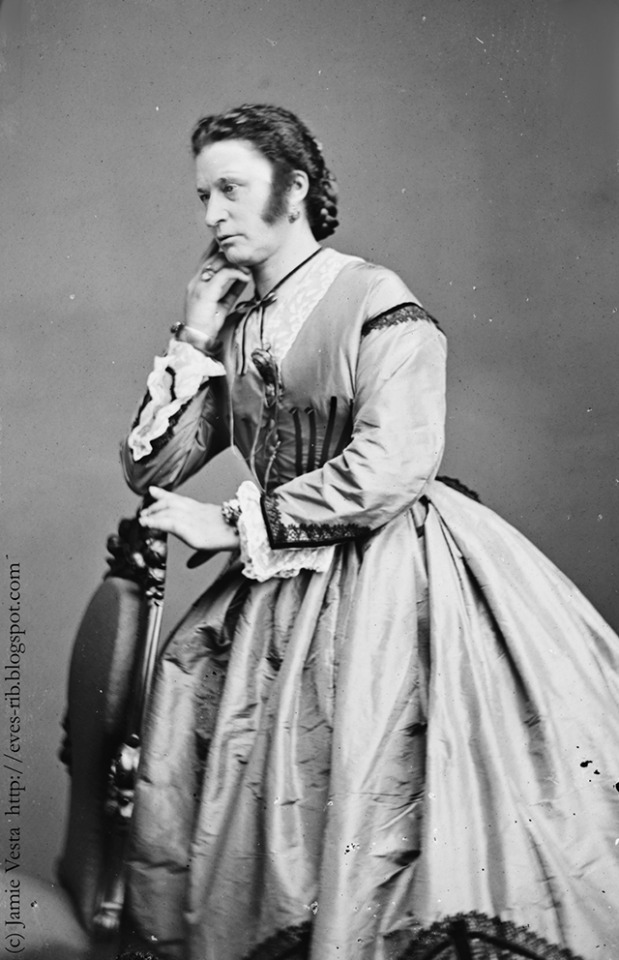

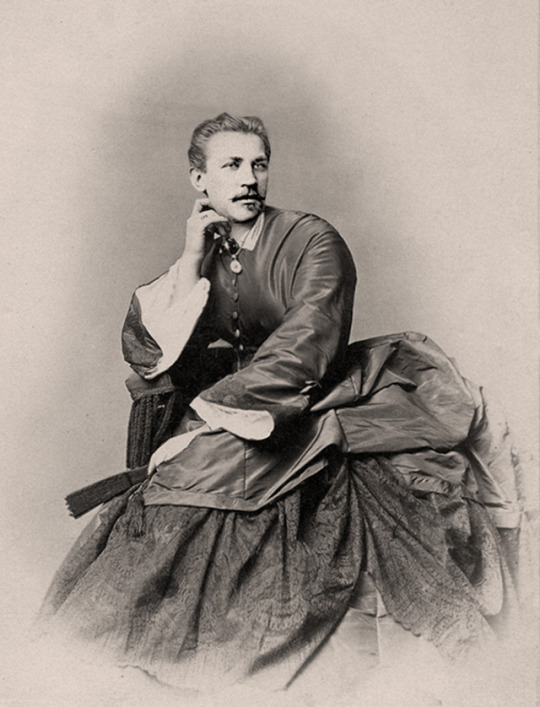
19th century guys wearing dresses! :D
#the first two are fanny and stella two iconic cross-dressers of the victorian era! :D#idk who the others are but they're also awesome!! :D#look at how fab they are!!!! :D#SoFAB#this would inspire rewrite erik for sure! :')#also the first featured article after the one i linked was christina nilsson! ;)
7 notes
·
View notes
Text
That One Reference to That One Musical In Lies of P (that I think only I noticed)
Yeah you heard me.
Aside from the multitude of Pinocchio characters that litter the entirety of Krat, there's also a few other characters that are a reference to other things if you look hard enough. Veningi and his references to Batman, Giango and his reference to an actual famous alchemist - so on and so forth.
But there's one particular pair I don't see get mentioned in that list and would like talk about more:
The Red Actress and The White Lady
(spoilers below cut)
So first off there's actually two references between these characters - a reference to a musical AND a reference to a fairy tale - but since I said musical in the title I'll start off there.
Before we can reach the King of Puppets at the Estella Opera House, we have to brawl our way through Rosa Isabelle Street which is connected to Hotel Krat. If you roam around a bit, you get to encounter one of the fanciest Stalker bosses that wander the formerly entertaining street - The White Lady.

And no, her name is not Karen, but we'll learn that eventually.
Apart from being a difficult boss encounter and having the coolest outfit and mask EVER, her voice lines reveal early on that she is the sister of the famous Adelina Corday, the Red Actress. Given how devastating the Puppet Frenzy has been for every party involved, it's unsurprising that she takes her frustration and grief out on every puppet she comes across as it's likely her sister has perished to the hands of said puppets. Her locket even shows how close they were, wishing to share the stage of their dreams alongside each other.
Or so we presume.
After fighting our way through the streets we can finally reach the Opera House and encounter Adelina herself, tucked away in a side hall attempting to sing a song with her petrified throat and apologize to a woman named "Patricia". From there you can take on her last request - to feed her a plump apple full of juice to quench her thirst and restore her parched throat (using the Red Apple you can purchase from Polendina after finding a Krat Supply Box).
If you don't find her prior to fighting the King of Puppets, however, you only find her dead body lying on the ground with a locket containing a torn portrait of a girl and a scratched out name. Finding her prior to the fight will reward you her record "Fascination" along with said locket.

Now if you guys aren't getting the musical references yet (The White Lady's white mask, this Actress, and the ghastly theater with a swinging Chandelier prior to entering the King's boss arena) they're a nod to the Phantom of the Opera musical. However, Adelina's not a reference to the protagonist, Christine Daae -- she's actually a reference to Daae's rival, the Prima Donna Carlotta.
See, the characters Christine Daae and Carlotta were actually based on two real opera singers who also shared a rivalry: Christina Nilsson (left) as Christine Daae and -- wait for it -- Adelina Patti (right) as Carlotta Giudicelli who, in some adaptations, wore red as her main color.
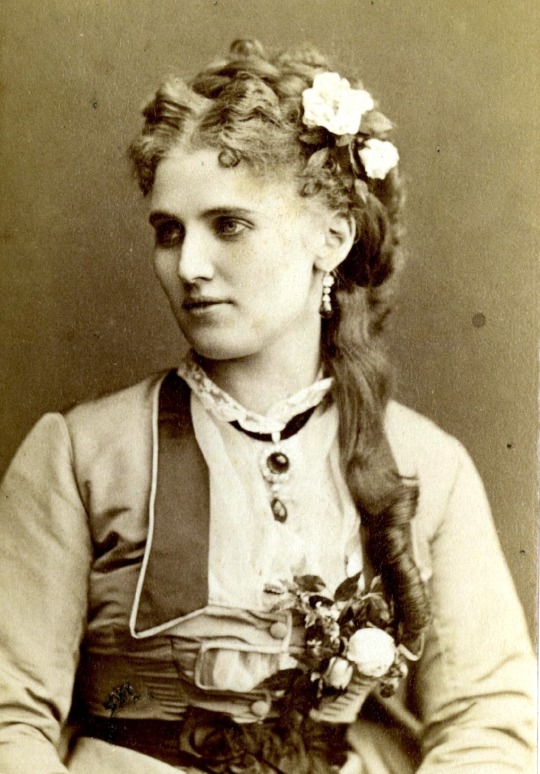
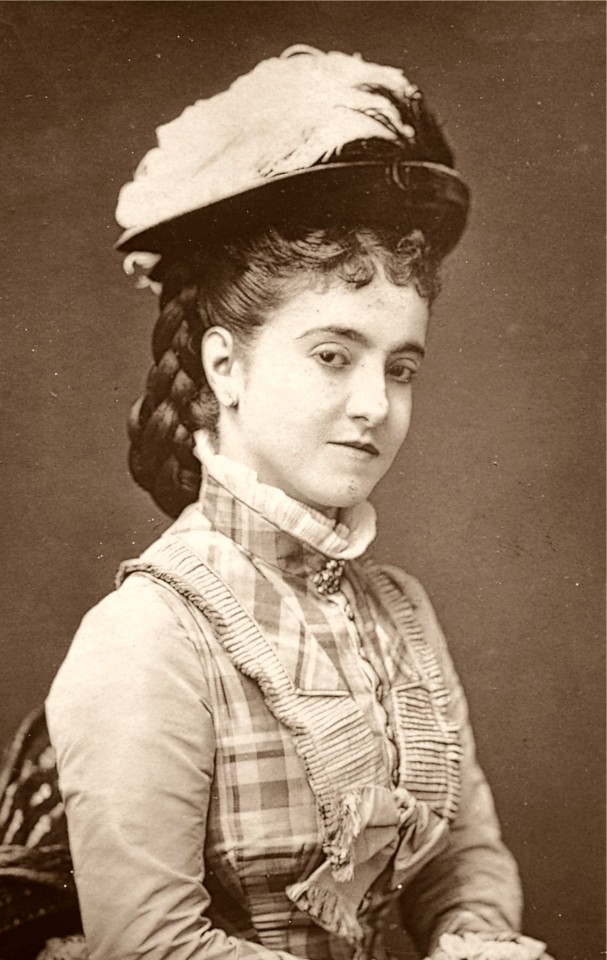
The reason that's so important is because when you complete her quest, Adelina in the game asks that we listen to her final confession before she dies: while striving for stardom her jealousy provoked her to get rid of her biggest rival by tricking her into drinking poison that would ruin her throat and prevent her from singing for good:
Patricia Corday, her sister, whom she is uncertain about the fate of given that she is unable to leave the Opera House.
Well, we know what happens.
We kill her prior to arrival, not as Patricia Corday but as the White Lady.
Yeah. Kinda messed up ;-;
So now aside from being the angelic singer who could have become "The White Goddess" according to one of her fans, The White Lady has become the Phantom of the Opera herself as she is unable to show her face on stage due to the lack of singing voice after being poisoned. Or you could argue Adelina became the Phantom as she's the one who dies alone in the Opera House. Either way, both sisters suffer a horrible fate apart from each other, with neither knowing what happened to the other.
Speaking of sisters, guess what fairy tale involves a pair of color coded sisters written by the Grimm brothers:

Snow White and Rose Red
Now I know the two aren't related to the other Snow White fairy tale (also written by the Grimm bros) but given how much crossover references are in Lies of P it doesn't surprise me Neowiz decided to merge the two stories together so bear with me.
The sisters can fill in each other's roles as Snow White (The White Lady) and Rose Red (The Red Actress), but the rest of their story follows the original Snow White and the Seven Dwarves:
Adelina, the jealous sister, tricks Patricia into drinking poison that ruins the source of her charm the same way the jealous step mother tricks Snow White into eating a poisonous apple so she can be the prettiest person on the planet. Ironically, Adelina is the one who perishes after eating an apple - petrified and frozen by the disease, while Patricia became her own Prince by becoming a Stalker after her voice became ruined.
It's a loose reference, sure, but honestly it's a pretty cool one nonetheless!
I'm really looking forward to all the other references the game devs decide to hide in Lies of P (heck I didn't even put together Champion Victor being a Frankenstein reference or Murphy the Robo Cop boss), along with maybe future games they have in store (I see you Rise of P ending I know).
But I'll end my thoughts here for now! Check out the game yourself if you ever get the chance, it's SO worth it!!
#lies of p#lop#lies of p spoilers#lop spoilers#adelina corday#adelina the red actress#the red actress#the white lady#white lady boss#patricia corday#text post
43 notes
·
View notes
Photo

Black Circle will be released on Blu-ray on September 5 via Synapse Films. The 2018 Swedish/Mexican psychological horror film comes with Rickard Gramfors' soundtrack on CD.
Adrian Garcia Bogliano (Late Phases, Here Comes the Devil) writes and directs. Thriller: A Cruel Picture’s Christina Lindberg stars with Felice Jankell, Hanna Midfjäll, Erica Midfjäll, Hanna Asp, Johan Palm, Hans Sandqvist, and Inger Nilsson.
Black Circle is presented in high definition with Swedish DTS-HD MA 5.1 Surround Sound and English subtitles. Special features are listed below.
Special features:
Audio commentary by director Adrian Garcia Bogliano
Inside Black Circle – Behind-the-scenes featurette
Interview with writer-director Adrian Garcia Bogliano and actress Christina Lindberg
Don’t Open Your Eyes – Original short film
Teaser trailer
Still gallery
Soundtrack CD composed by Rickard Gramfors
Two sisters, Celeste and Isa, fall under the terrifying spell of a mysterious vinyl record from the 1970s. Used to help with stress and bring the listener to a state of calming self-hypnosis, the recording has the unfortunate side-effect of manifesting a doppelganger of the listener into our world. This “double” then grows stronger by the day to copy and take over the life of the person who played the vinyl.
Seeking the help of the woman who originally created the recording, hypnotist Lena Carlsson (Christina Lindberg), Celeste and Isa try to banish the doppelgangers back to their own world before their lives are lost forever.
Pre-order Black Circle.
#black circle#horror#christina lindberg#synapse films#adrian garcia bogliano#dvd#gift#thriller a cruel picture#thriller: a cruel picture#late phases#here comes the devil#psychological horror
24 notes
·
View notes
Text

Caption: Marriage of Mademoiselle Christine Nilsson and M. Rouzaud in Westminster Abbey. Illustration for The Graphic, 3 August 1872.
Nilsson married Auguste Rouzaud (b.1837) at Westminster Abbey, London, on July 27, 1872. The wedding was boycotted by the groom's family. The marriage lasted until February 1882 when Rouzaud died in Paris after a period of illness. Source: Wikipedia
August Rouzaud didn't enjoy watching his wife on stage in Paris. She could sing wherever she wanted, but not in Paris. During this first marriage Christine appeared a lot in London and on tours. August Rouzaud eventually became mentally ill and was put in an asylum, where he used to climb the trees in the garden believing that he was a rising stock market. Source: Library of Nineteenth Century Photography
In March 1887, Christina Nilsson married Don Angel Ramon Maria Vallejo y Miranda, Count de Casa Miranda (b.1832), a Spanish journalist and diplomatic official. The wedding took place at La Madeleine, Paris. Her marriage made Nilsson the Countess de Casa Miranda.
#christine nilsson#l'eglise de la madeleine#poto adjacent#opera#westminster abbey#i wish i had an image of the wedding at the madeleine
31 notes
·
View notes
Text
The Gilded Age, Ep.2x01 – You Don’t Even Like Opera (Spoilers)
I probably should have rewatched, or at least read my previous posts, before watching this episode. I have a feeling I missed a few things because I couldn’t remember who all the characters were. This episode was quite good. It was also pretty much setup for the season, so I’m just going to give a quick recap of some of the characters.
Gorge Russel is having problems with his workers. Seems their asking for unreasonable things like living wages and the ability to not die on the job (shocking). It seems like George is really going to be a Robber Baron in this season. Let’s see how much we’ll like him at the end.
Marian has been secretly teaching at a school. Agnes is unhappy with this. This is probably why she will try to get Marian to marry…uh, it’s Agnes’ husband’s nephew. So, far he seems quite nice. However, he is older the Marian and he has a teenage daughter. So, yeah, conflict between Agnes and Marian.
Ada meets the new Pastor (?) of the church (I honestly can’t remember what title he was given). We’ve seen in the previews that they will fall for each other. But nothing really happens in this episode except they meet.
Larry has been remodeling the Russells’ new Newport house. As this job is finished, he’s looking for new work. Just so happens there’s a rich, young widow looking to remodel her home.
Oscar is beaten up and decides that he needs to give up his wild ways. He sets his sights on Gladys (again), but believes Gladys is giving him the cold shoulder as she never responded to his letters. Turns out, Gladys never got the letters. Oscar proposes. Gladys isn’t sure she wants to marry him, but does recognize this may be her way of getting away from Bertha.
We find out the Peggy’s son died six months previously of Scarlet Fever. This, of course, has left a gulf between Peggy and her father. Not to mention Peggy’s mother and Peggy’s father. The father does admit that what he did was wrong, but it’s a bit late for that. Peggy realizes that, for her own sake, she needs to leave her parents home and asks to come back to work of Agnes.
Bertha is still trying to make her way into society and she has done quite well for herself. At least, Ms. Astor recognizes she can’t just shut Bertha out (better to keep your enemies close). Of course, Bertha isn’t allowed everything yet as she does not have a box at the Music Academy. Which, it’s very true that there’s a long waiting list, but Ms. Astor could easily get Bertha to the top of the list if she so chooses. Which she doesn’t. And so, Bertha is going to show the old money they can’t just keep people out by helping to build the new Metropolitan Opera. And, yes, this war between (music) houses was a real thing. Bertha announces to the world her backing at a dinner that she hosts and Mrs. Astor attends. And also has a sneak peak of the first production of the Met, Faust, with none other than Christina Nilsson singing the part of Marguerite. Oh, and Nilsson just happens to be at Bertha house, in costume, and she begins to sing.
Now the funny/interesting thing is, the song she’s singing just so happens to be featured in the musical “The Phantom of the Opera,” which is about an outcast of society who has managed to manipulate his way into kind of taking control of this Paris Opera House (they think he’s a legit Phantom as bad things keep happening) and, yes, one of his demands to keep the peace is his own private box. True Bertha is no phantom, but I mean….
#the gilded age#the gilded age spoilers#marian brook#ada brook#agnes van rhijn#bertha russell#geroge russell#peggy scott
11 notes
·
View notes
Text

It has heen well suggested that M. Amhroise Thomas's lyrical version oi Hamlet should have been called Ophelia. The question would not then have been raised in too direct a manner, whether or not Shakespear's tragedy has received worthy treatment at the hands of its operatic adaptors. Moreover, Ophelia, who is not the chief character, who is scarcely even a character of the first degree of importance, in Shakespear's Hamlet, is the principal personage, both in a musical and in a dramatic point of view, in the Hamlet prepared for the composer by MM. Barbier and Carre. Finally, the longest, most elaborate, and altogether the best scene in the operatic Hamlet y does not exist in the Hamlet of Shakespear at all. Here the name of Shakespear cannot be used against M. Thomas ; and if he had confined himself to this scene and entitled it The Death of Ophelia , one universal feeling of admiration would have been expressed for the work. The object, however, of M. Thomas was to produce not a poetical little cantata, but a grand opera containing a great part for Mdme. Nilsson ; and accordingly the scene of OpheHa's death is followed by an act which is superfluous, and is preceded by three acts which are in a great measure irrelevant. The parent notion of the opera was certainly the idea that the fair-haired, soft-voiced, Swedish soprano would be in every way an admirable representative of Shakespear's Scandinavian heroine; and so indeed she has proved. Mdme. Nilsson has deeper qualifications for the part than purely external ones, which, nevertheless, may be said to suggest others. All the sentiment of the character seems to belong to her naturally, so that as an actress alone, if she had not a note to sing, she would still be an admirable Ophelia. Then the pure fresh quality of her voice is quite in harmony with the rest of the personage. If the Shakespearian heroines may be divided into two categories, like the heroines of modern opera, Ophelia is eminently a " light soprano '* part, as Lady Macbeth is a part for a " dramatic soprano." The amount of Scandinavianism discoverable in the character of Shakespear's Ophelia, is, probably, very slight ; but M. Thomas has given a tinge of national colour to the music sung by the Ophelia of his opera. This he has done, not by the vulgar expedient of dragging in one national air in complete form, but by reproducing the character of the Swedish melodies (for operatic purposes Sweden and Denmark are one) in both the heroine's grand scenas, and by employing here and there actual passages of Swedish origin.
In the power of characterisation belonging to music lies one of the strong points of opera as a form of art. A Scotchman sings something in the Scotch style, or a Russian something in the Russian style, and the nationality of the personage is at once painted beyond the possibility of mistake. Neither does M. Thomas make any endeavour in Hamlet to give us a Scandinavian finale, wisely contenting himself with such a finale as the Hebrew-Prussian Meyerbeer might have wi-itten. Ophelia's solos are interspersed with little Scandinavian snatches ; and the villagers of the neighbourhood of Elsinore dance, in one place, to a quaint but very graceful melody which is apparently of Scandinavian origin. But another dance tune in the same scene is clearly derived from the Anglican, not to say cockneyfied, tune of *' Billy Taylor." Others, again, might have been written for any ballroom of the present day. M. Ambroise Thomas may, indeed, be acquitted of all intention
to give a Scandinavian character to his music elsewhere than in the strikingly-coloured part of Ophelia, and in the dance tunes of her young companions.
There are few characters, one would think, in all dramatic literature, less favourable for musical treatment than Hamlet. The address to the ghost, the interview between Hamlet and his mother are, to be sure, dramatic enough in the ordinary sense of the word, and furnish suitable groundwork for operatic scenes. But the character of Hamlet is chiefly known to us from the two great monologues ; and the monologues, though a composer of the very highest genius might, doubtless, be able to find appropriate music for them, are not the sort of ** words " that any ordinary composer would like to set, or could adequately deal with. M. Thomas, differing from all the Italian composers who have grappled with Shakespear, seems to have made an honourable endeavour to give to his principal personages their proper musical physiognomy. Verdi (to take a flagrant instance) makes Macbeth, in the most terrible moment of his career, when its tragic termination already stares him in the face, sing a sentimental air of the conventional pattern, which might just as well be sung by Renato in the Ballo in Maschera, and which — if it had not been written some years earlier — would be regarded as a very close imitation of Balfe's ** Come into the garden, Maud." Signor Verdi would doubtless have treated ''To be or not to be?" as he has treated the
*' words " which in the libretto of Macbeth replace *' Canst thou not minister to a mind diseased?" &c. But though his intentions would not have been so meritorious as that of M. Thomas, the thing achieyed would have been at least melodious. The air would have. had no philosophical character, but it would have been singable and what is called " expressive." It would have been, so to sa}^ in rhyme ; whereas M. Thomas's Hamlet sings persistently in blank verse. The only notable case in which the operatic Hamlet breaks into evenly -balanced, sharply-defined rhythm is (if we except a few graceful passages in the finale to the second act) in the drinking song which he addresses to his friends the players in lieu of the well-known hints on acting. Here, again, we are reminded of the scene in Macbeth where the King '^ obliges the company with a song," to be interrupted in the midst of his efiusion by Banquo's ghost. A drinking song is worth nothing in an opera if not relieved at intervals by some anti -jovial incident or reflection ; and in M. Thomas's work the necessary contrast is supplied by a passing change in Hamlet's ever-changing humour.
After Ophelia and Hamlet, the only personage whom the composer seems to have thought it worth while to characterise is the ghost. Alas ! poor ghost. At the thought of this dreadful, because preternaturally dull and dismal, apparition, we can only cry with Hamlet:
" Angels and ministers of grace defend us " — from ever meeting with such a ghost again. In the first place we deny his ghostliness. It is not the voice of a disembodied spirit that we hear, but of a dead man singing. The statue of Don Giovanni (of which it would be unfair to speak if M. Thomas did not in a certain way invite the comparison) repeats the same note to varied harmony, then repeats another note to another succession of chords ; but the dead body of the King of Denmark emits the same sound — makes the same noise, that is to say — so unintermittently for so long a time, that instead of the divine sentiment of terror inspired by the figure on horseback, we feel the sort of awe and about the same admiration that would be excited in us by the unlookedfor appearance of an undertaker's mute. However, in these operatic presentations of great di-amatic masterpieces {Faust, Mignon, Romeo and Juliet, and now Hamlet) "realism" is the great principle cultivated; and it was, perhaps, intended that the music given to the ghost of Hamlet's father should be directly suggestive of the graveyard.
Much has been said about M. Thomas's knowledge of orchestral efi'ect, but it must be possible to abuse such knowledge. "If God had given me, instead of the faculty for creating, capacity forjudging, I do not know,** said the late Alexandre Dumas in one of his most amusing prefaces, " whether I should have had wings powerful enough to raise me to the level of the poet; but I think I should have had sufficiently robust legs to be able to walk round him." Without presuming to criticise M. Thomas's orchestral work, one may say, judging only by its effect, that it is laborious and pretentious writing. It is in many cases " full of sound and fury," whatever it may signify. A melody, or fragment of melody, is often begun on one instrument, continued on a second, and finished — or left unfinished — on a third. In some of the most agitated portions of the opera the accompaniments suggest not merely agitation, but epilepsy. In others they recall the view taken of modern instrumentation by a certain satirist, who declares that its great secret consists in treating trombones as clarinets, and assigning violin passages to the bassoon. In many places, on the other hand, especially in the quieter scenes, the combinations of instruments are charming.
The composer of so many agreeable operas in the light style and of so much pretty ballet music, seems in Hamlet to have forced his talent. Yet a decided exception must be made in favour of his truly poetical Ophelia ; and opera-goers must at least thank M. Thomas for having furnished one of the most graceful and accomplished artists on the lyric stage with a part which suits her as if she had been born for it.
#classical music#opera#music history#bel canto#composer#classical composer#aria#classical studies#maestro#chest voice#Christina Nilsson#Christine Nilsson#dramatic coloratura soprano#coloratura soprano#soprano#the Swedish Nightingale#Swedish Nightingale#The Nightingale#Hamlet#Ambroise Thomas#Ophelia#Paris Opera#Opéra de Paris#Opéra Paris#Ophélie#Mad Scene#classical musician#classical musicians#classical history#opera history
4 notes
·
View notes
Text
TGA S2 Bingo Card Recap for 2.01 - You Don't Even Like Opera
SPOILERS BELOW, OBVIOUSLY!
Free Space
Zipper down the back of a dress: on Carrie, Aurora, and Marian, among others...



#zipgate
Squares to Check Off After 2.01
A character gets or moves into a new house: Larry gives Bertha a tour of their renovated Newport home
A dramatic reveal occurs at a party: Flora McNeil discovering her father's vocation; Marian teaching watercolors at a girls' school
Agnes yells at a family member: Agnes yells at Marian about teaching watercolors at a girls' school
Agnes yells at Marian: see above
Drinking alcohol in the morning: Oscar in the bar after the Easter service
Easter Parade: Walking to church sequence [previously listed as blackout-preventing; in retrospect I think they did enough of it for it to count!]
John kisses Oscar for a change: John kisses Oscar's hand
Historical figure namedrop: Opera benefactors and opera singers, businessmen
Historical figure shows up: Christina Nilsson, Jay Gould
Peggy starts the season in mourning: Peggy's son, Thomas, died offscreen between seasons of Scarlet Fever
Putting on a hat montage: Opening sequence
Raikes/Bingham wedding mentioned: The new rector mentions he'll be officiating it
Russell servant/Van Rhijn servant romance: Jack flirting with Adelheid and inviting her over
Subjective Squares After 2.01
A meetcute: Dashiell & Marian
Incredibly serious topic immediately followed by a frivolous conflict given the same weight: Any scene following a Peggy scene or several Oscar scenes
Secondhand embarrassment/extreme cringe: Oscar proposing to Gladys
Wait and See for a Better Option in a Future Episode
A scene at the opera: Christina Nilsson singing at Bertha's dinner
A walk in the park: John & John's New Friend
Gladys stands up to her mother: Attending Aurora Fane's party
Marian wears something yellow and floofy
Someone is caught in a lie: Marian's whereabouts on Thursdays, John's suspicions about Oscar's injuries
Someone makes a scene at a dinner: Flora McNeil "biting her tongue"
9 notes
·
View notes
Text

#Christina Nilsson#Christine Nilsson#19th century#bel canto#swedish nightingale#opera#coloratura#singer#christine daaé#soprano#coloratura soprano#dramatic coloratura soprano#the nightingale#chest voice#opera singer#aria#diva#primadonna#le fantome de l'opera#le fantôme de l'opéra#the phantom of the opera#gaston leroux
8 notes
·
View notes
Text
Julian Fellowes is doing his best to activate my Phantom of the Opera conditioning for inscrutable reasons. Christina Nilsson performing the Jewel Song feels targeted. What do you want from me old man??
6 notes
·
View notes